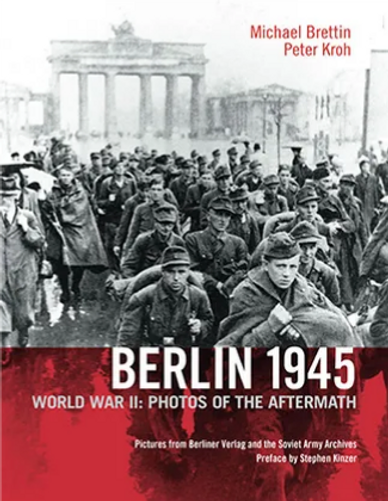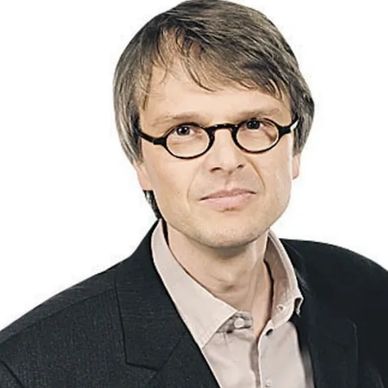Berlin in World War II
Berlin 1945

Berlin 1945
World War II: Photos of the Aftermath
By Michael Brettin and Peter Kroh
Translator: Cindy Opitz
Genre: City History
Softcover: 218 pages, 177 b/w photos
Dimension: 8.5'' x 11''
Sugg. Retail: $24.95 / 24,- €
ISBN: 978-3-96026-014-1
Neu: 978-3-96026-002-8
About the Book
Berlin 1945: World War II is over in Europe. The Soviet army has conquered Berlin, a city reduced to rubble, and now under martial law. Soldiers from America, Great Britain, and France will move in a few months later. Broken tanks and makeshift barricades are littering the streets, tenements and churches were turned into bombed-out shells, tunnels have been flooded and train tracks destroyed. German soldiers are been hauled off to POW-camps in Siberia, while old men are cutting up dead horses for food, women are trading clothing for survival, and children are left to their own devices in the ruins. And the victors, Russian soldiers of the Red Army, look as much exhausted as the defeated. These rare pictures have been taken by photographers of the Red Army immediately after the surrender and ended up in the archive of Berliner Verlag. They are published for the first time in the United States, allowing a glimpse into an era of destruction and desperation, but also survival and rebuilding. Christian Science Monitor-Reporter Jason Walsh calls Berlin 1945 a "historical archive that acts as a window on the aftermath of total war. " With 177 black-and-white photos and a preface by Stephen Kinzer, former New York Times Bureau Chief in Berlin.
Michael Brettin
Michael Brettin
Michael Brettin, born 1964, studied History, Politics, and Slavistics. He holds a PhD in History from Hamburg University about the nationality question in the Soviet Union under Gorbachev. He is also a graduate of the Hamburg School of Journalism. He works as an editor for the daily paper Berliner Kurier. His work on the history of the Berlin Wall was published in twelve issues and as a magazine.
Born in 1950, Peter Kroh has worked as a photo reporter in East Berlin for BZ am Abend. After the Wall fell, the paper was acquired over by Gruner & Jahr and renamed Berliner Kurier. Kroh became photo editor, a job he held for two decades. Today, he is retired.
Berlin in World War II
Get the Book in Stores
Cold War History
Berlin in the Cold War

Berlin in the Cold War
Author: Thomas Fleming
Translator: Penny Croucher
Genre: City History
Softcover, 90 pages / 51 pics / 3 maps
Dimensions: 7’’ x 10’’
Suggested Retail: $12.00
ISBN 978-3-96026-006-6
About the Book
Berlin in the Cold War vividly describes the conflict between the two superpowers—the USA and the Soviet Union—as it played out in Berlin, the divided city that was frontier, spy post, and battlefield all in one. The book highlights the dramatic events that affected the entire world: the 1948 blockade by the Soviets that caused the division of the city, the airlift that rescued West-Berlin, the June 1953 uprising against the Communists in East Berlin that was crushed by tanks, the sudden construction of the Berlin Wall in 1961, followed by stories of escape and espionage, the visit of John F. Kennedy and, finally, the fall of the Iron Curtain. The daily paper Berliner Morgenpost wrote about the book: “Thomas Flemming managed to tell the whole story of the divided city on just 80 pages, without missing a beat.” The book includes numerous pictures and a map of all the Cold War places in Berlin.
Thomas Flemming
Thomas Flemming
Thomas Flemming studied history at Free University in West-Berlin. Since then, he has written numerous books and newspaper stories mainly about post-war history in Germany, and he has curated a number of exhibitions on that topic, most importantly “The History of World War I” at the Deutsches Historisches Museum in Berlin.
Get the Book in Stores
The Berlin Wall
Berlin in the Cold War

The Berlin Wall Today
Author: Michael Cramer
Translator: Cindy Opitz
Genre: City History
Softcover, 102 color pages
Dimensions: 8.5'' x 8.5’’
Sugg. Retail: $15.95, 16,00 €
ISBN: 978-1935902-10-2
ASIN: B01FKTIW82
Release: Spring 2015
About the Book
The Berlin Wall Today, which features more than one hundred color pictures, takes the reader on a tour of the last traces and fading memories of the Wall—to memorials, parks, back yards, train tracks, factories, churches, and Prussian cemeteries. It tells stories of struggle, desperation, survival, and rebirth and of a history that shaped the post-war world. It also shows how the people of Berlin are reclaiming and memorializing the ground where the Wall once stood: Mauer Park, where young people from all over world gather to party; a guard tower that is now the Museum of Forbidden Art; the Topography of Terror Museum, which includes the former Gestapo headquarters; and landmarks such as the Reichstag, the East Side Gallery, and Checkpoint Charlie.
Michael Cramer
Michael Cramer
Michael Cramer moved to Berlin in the 1970s, where he became a school teacher and got involved with Green Party politics. He became the go-to politician for transportation issues as a member of the Berlin City Council. From 2004 to 2019, he was a member of the European Parliament. His commitment the memory of the Wall goes way back: Visiting Berlin in 1963, he used his first camera that his aunt had given him to take photos of the Wall at Bernauer Straße.
Get the Book in Stores
Coming Soon in an Updated Edition
Berlin for Free

Berlin for Free
Author: Monika Märtens
Translator: Cindy Opitz
Genre: Guidebook
Softcover, 104 pages
Dimensions 5’’ x 8’'
Suggested Retail: $10.95
ISBN: 978-1-935902-40-9
Release: Winter 2010
About the Book
Berlin for Free is an invaluable guide for the frugal traveler, to everything free in Berlin: Underground pop, classical music, and concerts in the park, art shows and exhibitions, museums and movies, readings and theater, sport events, city tours, gay life, and street fairs. All of these no-cost opportunities for kids and grown-ups alike are neatly arranged and easy to find. The book also includes more than two hundred addresses, phone numbers, and websites—and all the information is fact-checked and recently updated.
Monika Märtens
Monika Märtens

Monika Maertens, the author, is a student at the Berlin University of the Arts. Martin Blath, the original publisher and co-author, came to Berlin in 2002 from the Rhine as a freelance journalist, he also worked in PR. Two years later, he founded Verlag an der Spree—because he loves Berlin, the most exciting city in Europe.

